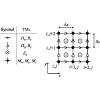当前位置:
X-MOL 学术
›
Phys. Rev. Appl.
›
论文详情
Our official English website, www.x-mol.net, welcomes your feedback! (Note: you will need to create a separate account there.)
Wide-Band Electromagnetic Wave Propagation and Resonance in Long Cobalt Nanoprisms
Physical Review Applied ( IF 4.6 ) Pub Date : 2020-03-30 , DOI: 10.1103/physrevapplied.13.034073 M.M. Aziz , C. McKeever
Physical Review Applied ( IF 4.6 ) Pub Date : 2020-03-30 , DOI: 10.1103/physrevapplied.13.034073 M.M. Aziz , C. McKeever

|
Electromagnetic wave interaction with confined metallic magnetic structures is complex due to the excitation of nonuniform electromagnetic fields and magnetic precession and spin-wave modes over length scales that are dependent on the geometric, electromagnetic, and micromagnetic properties of the magnetic structures. Here, we solve the coupled system of Maxwell’s equations and the Landau-Lifshitz-Gilbert equation using a stable algorithm based on the finite-difference time-domain method to study the transient wide-band electromagnetic propagation and resonance in infinitely long cobalt nanoprisms with a square cross section of side lengths 50–1000 nm. In particular, we identify the resonance mechanisms through studying the local transient and spectral distributions of magnetization in the prisms. The nanoprisms are excited by an axially polarized plane wave at normal incidence with a 70 GHz Gaussian pulse profile. For this incident wave condition, the simulations confirm that resonance in the cobalt prisms is excited mainly by the current-induced magnetic fields and indicate a magnetization curling resonance mode for prism side lengths less than 100 nm. The eigenfrequencies for the curling mode are confirmed theoretically using a model for an equivalent long circular cylinder with radial spin-wave modes. For prism side lengths longer than 100 nm (but less than the nonmagnetic skin depth), the magnetic response is confined to thin regions along the prism edges due to resonance-induced skin effects. The simulations indicate predominately uniform magnetization precession in the confined edge regions with increased pinning in the corners. The uniform resonance mode in the central part of the edge regions increases in intensity with prism size, with frequency described using Kittel’s ferromagnetic resonance frequency of a thin planar structure. A higher-frequency size-independent uniform resonance mode is observed in the corner regions with frequency determined by the local demagnetizing factors. Local and integrated power absorption spectra are calculated using the simulated transient magnetization and fields, and confirm the resonance modes and frequencies in the cobalt prisms and their size dependence. The profile of the local power absorption spectra is also used to estimate the thickness of the confined edge regions or magnetic skin depth in the cobalt prisms at the fundamental resonance mode and is found to be approximately 50 nm. The outcomes of this work would benefit the design and engineering of lightweight and compact materials and devices incorporating metallic magnetic nanostructures. This work also provides a foundation for further modeling and understanding of electromagnetic transmission and propagation in more complex metallic ferromagnetic structures and composites excited by different electromagnetic wave conditions.
中文翻译:

长钴纳米棱镜中宽带电磁波的传播和共振
电磁波与受限金属磁性结构的相互作用是复杂的,这是由于在取决于磁性结构的几何,电磁和微磁特性的长度范围内激发了不均匀的电磁场以及磁旋进和自旋波模式。在这里,我们使用基于时域有限差分法的稳定算法,求解麦克斯韦方程组和Landau-Lifshitz-Gilbert方程组的耦合系统,以研究无限长钴纳米棱镜中的瞬态宽带电磁传播和共振。边长为50-1000 nm的正方形横截面。特别是,我们通过研究棱镜中磁化的局部瞬态和光谱分布来确定共振机制。纳米棱镜被具有70 GHz高斯脉冲轮廓的法向入射的轴向极化平面波激发。对于这种入射波条件,模拟结果证实钴棱镜中的共振主要被电流感应的磁场激发,并且表明棱镜侧面长度小于100 nm的磁化卷曲共振模式。理论上,使用具有径向自旋波模式的等效长圆柱体模型,可以确定卷发模式的特征频率。对于长于100 nm(但小于非磁性趋肤深度)的棱镜边长,由于共振引起的趋肤效应,磁响应被限制在沿着棱镜边缘的薄区域中。模拟表明,在狭窄的边缘区域中,由于拐角处的钉扎增加,主要实现了均匀的磁化进动。边缘区域中心部分的均匀共振模式随棱镜尺寸的增加而增强,其频率使用薄板状平面结构的基特尔铁磁共振频率来描述。在拐角区域观察到更高频率的尺寸无关的均匀共振模式,其频率由局部退磁因子确定。使用模拟的瞬态磁化强度和磁场来计算局部和积分功率吸收谱,并确定钴棱镜中的共振模式和频率及其尺寸依赖性。局部功率吸收光谱的轮廓还用于估计基本共振模式下钴棱柱中受限边缘区域的厚度或磁性趋肤深度,并且发现约为50 nm。这项工作的成果将有益于结合金属磁性纳米结构的轻巧紧凑的材料和设备的设计和工程。这项工作还为进一步建模和理解在不同电磁波条件下激发的更复杂的金属铁磁结构和复合材料中的电磁传输和传播提供了基础。
更新日期:2020-03-30
中文翻译:

长钴纳米棱镜中宽带电磁波的传播和共振
电磁波与受限金属磁性结构的相互作用是复杂的,这是由于在取决于磁性结构的几何,电磁和微磁特性的长度范围内激发了不均匀的电磁场以及磁旋进和自旋波模式。在这里,我们使用基于时域有限差分法的稳定算法,求解麦克斯韦方程组和Landau-Lifshitz-Gilbert方程组的耦合系统,以研究无限长钴纳米棱镜中的瞬态宽带电磁传播和共振。边长为50-1000 nm的正方形横截面。特别是,我们通过研究棱镜中磁化的局部瞬态和光谱分布来确定共振机制。纳米棱镜被具有70 GHz高斯脉冲轮廓的法向入射的轴向极化平面波激发。对于这种入射波条件,模拟结果证实钴棱镜中的共振主要被电流感应的磁场激发,并且表明棱镜侧面长度小于100 nm的磁化卷曲共振模式。理论上,使用具有径向自旋波模式的等效长圆柱体模型,可以确定卷发模式的特征频率。对于长于100 nm(但小于非磁性趋肤深度)的棱镜边长,由于共振引起的趋肤效应,磁响应被限制在沿着棱镜边缘的薄区域中。模拟表明,在狭窄的边缘区域中,由于拐角处的钉扎增加,主要实现了均匀的磁化进动。边缘区域中心部分的均匀共振模式随棱镜尺寸的增加而增强,其频率使用薄板状平面结构的基特尔铁磁共振频率来描述。在拐角区域观察到更高频率的尺寸无关的均匀共振模式,其频率由局部退磁因子确定。使用模拟的瞬态磁化强度和磁场来计算局部和积分功率吸收谱,并确定钴棱镜中的共振模式和频率及其尺寸依赖性。局部功率吸收光谱的轮廓还用于估计基本共振模式下钴棱柱中受限边缘区域的厚度或磁性趋肤深度,并且发现约为50 nm。这项工作的成果将有益于结合金属磁性纳米结构的轻巧紧凑的材料和设备的设计和工程。这项工作还为进一步建模和理解在不同电磁波条件下激发的更复杂的金属铁磁结构和复合材料中的电磁传输和传播提供了基础。



























 京公网安备 11010802027423号
京公网安备 11010802027423号